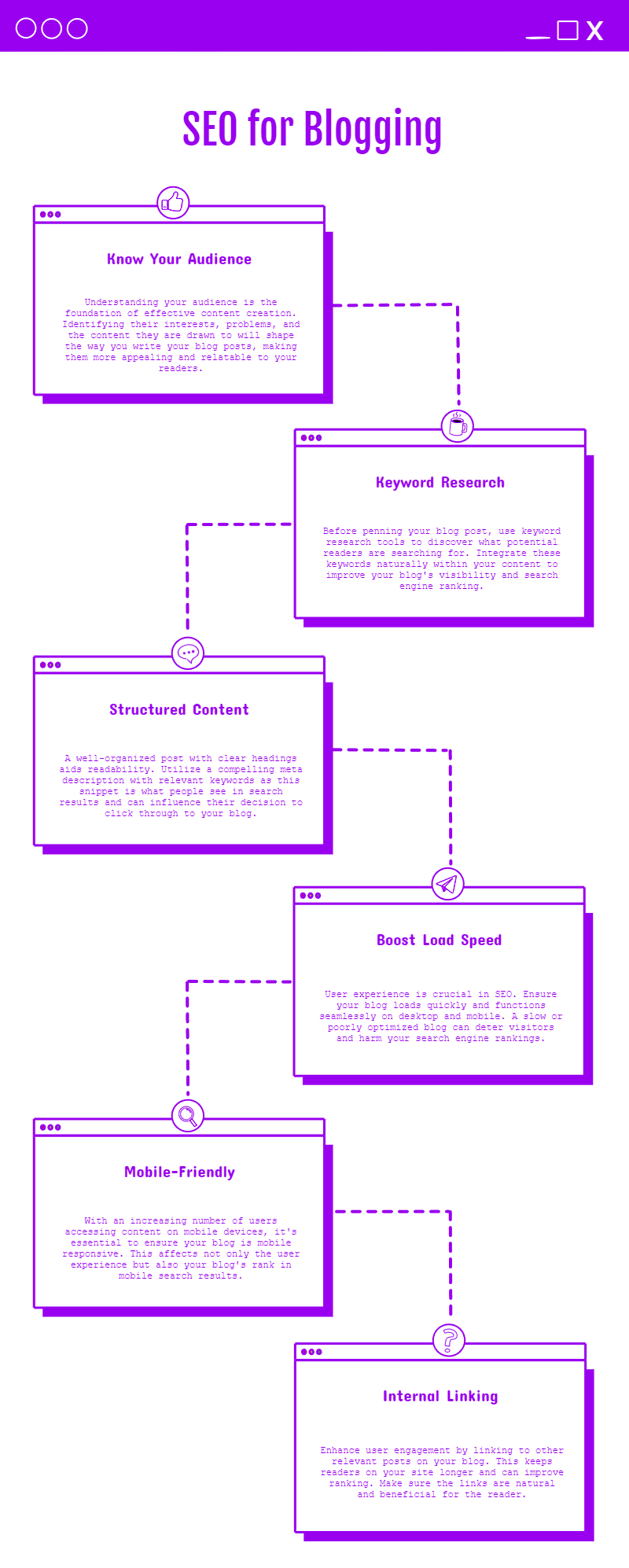
To make your blog[2] posts shine in the eyes of search engines, it’s vital to know your readers and what they search for. This means doing your homework on keywords. Tweak your blog’s layout, ensuring it’s easy to navigate. Make your content easy to digest and search engine friendly. Don’t forget the importance of links and the right SEO tools to get your blog noticed.
Keep track of your SEO tactics, always ready to change gear as search engine algorithms evolve. Keep an eye on what your competition is doing too. And don’t miss out on the power of structured data to boost your blog’s performance.
So, how do you make the most of each blog post? Stick around, we’re just getting started.
To truly tap into the magic of SEO for blogs, you need to understand it’s more than just tweaking content. It’s about fine-tuning everything – from the site’s layout to its core HTML[3] code – all to make your blog more noticeable on search engines.
But it doesn’t stop at content. It’s also about where you put your keywords, making sure your page loads quickly, and linking within your own site. These little tweaks can drive a huge amount of traffic to your blog. Take Google[4], for example. It can send a whopping 396,000 visitors to a blog in a month. That’s the power of good SEO.
By optimizing your blog, it can scramble up the search engine rankings, attracting more visitors and getting your work seen by more people. Remember, common SEO tasks involve more than just adding keywords. It’s also about optimizing title tags and creating a network of internal links. These strategies can help your blog connect with its audience, boost its online profile, and ramp up traffic.

.
Knowing who reads your blog is vital. It’s the first step to creating posts that are not just interesting but also easy to find online.
Let’s break it down:
Keyword research is like a compass for writing top-notch content. It’s about figuring out what words people use when they’re searching online. It’s like tuning into their conversation and joining in with the right words. It’s the first thing you do before writing to make sure your blog posts are on point and easily found.
Good keyword research can boost your blog traffic, pushing it up the search engine rankings. It pinpoints the top keywords to sprinkle throughout your posts. This makes your content more relevant, more engaging, and easier for your target audience to find. So, keyword research is a powerful tool for any blogger.
Let’s dive deeper into the world of SEO and see how the layout of your blog post can play a big role in making your content more easily found and enjoyed by users.
In short, a well-thought-out blog post layout can be a game-changer in boosting your SEO.
To boost your blog’s visibility online, you need to play by the rules of SEO. This means using popular keywords related to your topic. Doing this right could ramp up your blog traffic by a whopping 200%!
Next, use clear, simple headings that make it easy to scan your content. They don’t just make your blog more visible, they make it more user-friendly too.
Don’t forget meta descriptions. These are the little snippets of text that appear under your blog title in search results. If they contain your target keywords, people are more likely to click and read. And let’s not overlook images. They can boost your blog’s SEO ranking, especially if you use descriptive alt text.
Lastly, link your blogs together. This helps search engines find and index your content more effectively. But remember, SEO isn’t just about ticking boxes, it’s about creating engaging, valuable content that keeps your readers coming back for more.
Ready to elevate your website’s search engine ranking but not sure where to start? Let our expert team guide you through the maze of SEO with proven strategies and personalized advice. Contact us through our contact page or reach out directly via WhatsApp to start transforming your online presence today!
Let’s talk about how to enhance your blog’s visibility and performance on search engines, by focusing on on-page elements.
Ready to elevate your website’s search engine ranking but not sure where to start? Let our expert team guide you through the maze of SEO with proven strategies and personalized advice. Contact us through our contact page or reach out directly via WhatsApp to start transforming your online presence today!
Link building is the secret ingredient in the recipe of SEO for blogs. It’s like a magic wand that boosts your blog’s visibility and trustworthiness in search engine results. How does it work? You earn links from other websites, a bit like digital word-of-mouth.
A popular strategy is guest posting. Imagine writing for other blogs that share your interests. Your write-ups act like magnets, pulling in new traffic and increasing your blog’s reach.
Don’t forget about internal linking too. It’s like creating a map for your visitors, guiding them through your website and keeping them engaged.
There are two types of links: dofollow and nofollow. Both are important. Together, they create a mixed bag of backlinks, a positive sign in the eyes of SEO.
Remember, it’s not about how many links you have; it’s about their quality. High-quality links can make a world of difference to your blog’s SEO performance.
Harnessing SEO tools is key to enhancing your blog’s reach and pulling in more organic web traffic. Here’s how certain SEO tools can pump up your blog’s performance:
To stay on top of the ever-changing world of search engine optimization, you need to frequently review and tweak your SEO tactics. This ensures your blog posts stay highly visible and engaging.
Here’s a simple breakdown:
| SEO Tactics | Tools for Review | Needed Adjustments |
|---|---|---|
| Tracking keyword success, checking lien retour[5] quality, making sure content stays relevant | Google Analytics[1], A/B testing | Changes in algorithms, tricks used by competitors |
Google Analytics tracks how users interact with your site and the success of keywords. A/B testing shows what’s working and what isn’t. Checking the quality of your backlinks and the relevance of your content keeps your SEO tactics sharp. It’s crucial to regularly adjust to changes in algorithms and stay ahead of your competitors’ tricks. Using structured data markup helps search engines to better understand your content, which might boost your visibility in search results.
Making your blog post more searchable online isn’t rocket science. It involves picking the right words people are likely to search for, writing top-notch content, and describing it in an appealing way. You also need to consider how to name your webpage, use pictures effectively, and link to other resources both on and off your site. Don’t forget to make it easy to share on social media, and ensure it loads quickly and looks great on mobile devices. Stay tuned to learn more about how to make your blog post stand out online!
Making your blog more visible to search engines isn’t as hard as you might think. Start with simple steps like creating clear and concise meta descriptions for your posts. Optimize your images for faster loading and better visibility. Organize your URLs so they’re easy to understand. Make sure your blog looks good and works well on mobile devices.
Don’t forget about social media – share your posts there too! Use SEO tools that can help you get the job done. Focus on your visitors’ experience – make it as smooth and enjoyable as possible. Keep your content fresh by updating it regularly. Speed up your blog’s load time because nobody likes waiting. And don’t forget to link your posts to each other, it helps a lot!
When you’re crafting an SEO-friendly blog post, you need to consider a few key elements. First, find the right keywords – the ones your audience is using to find content like yours. Then, add a punchy meta description that gives a sneak peek of your post. Next, make sure your URL is clean and clear. It should reflect the content of your blog post and have your main keyword in it.
Now, let’s talk about the meat of your post – the content. Keep it simple and easy to read. Break it down into sections with headers to make it easier for both your readers and search engines to understand. Include images and make sure they’re optimized too. Name them correctly and add alt text with your keyword.
Don’t forget about links. Add links to other pages on your site and also to other relevant sites. This helps search engines understand the context of your content. Also, make sure your blog post looks good on mobile devices – a lot of people read on their phones these days.
To get the most out of your blog post, you should aim to use 1-2 main SEO keywords. Don’t go overboard or you might get penalized for keyword stuffing. Remember, it’s not just about the number of keywords, it’s about how you use them. Opt for long-tail keywords and LSI keywords that align with what your readers are looking for. With the help of SEO tools, you can figure out the right keywords and also see what your rivals are doing. And here’s a little secret…
